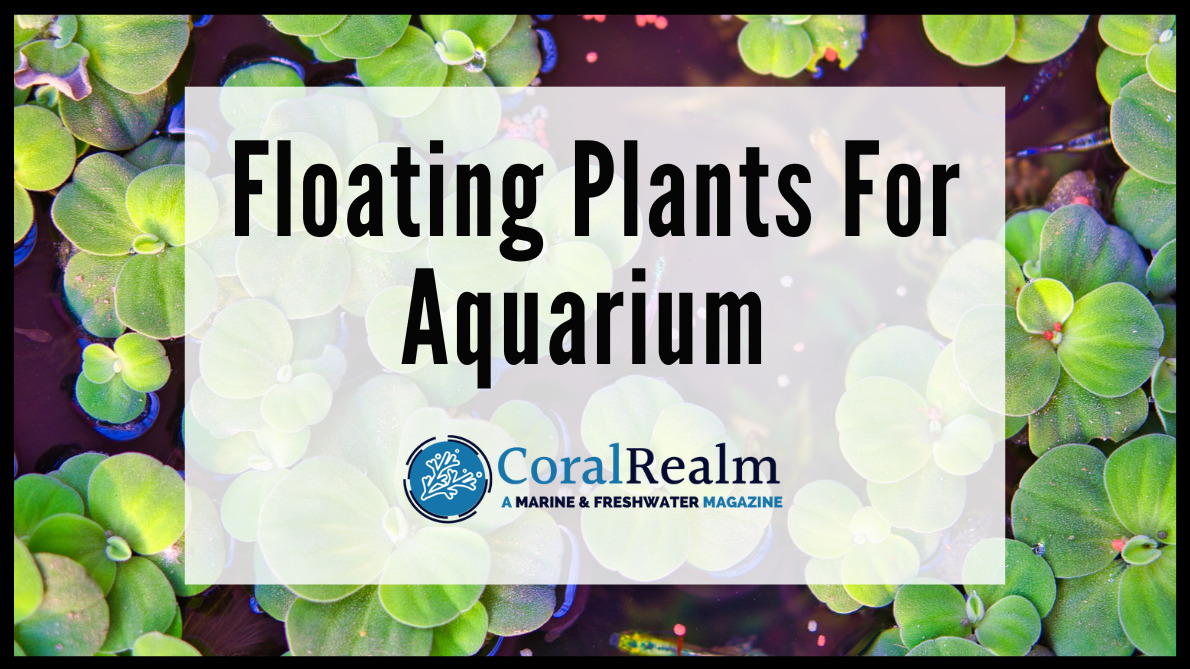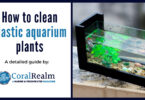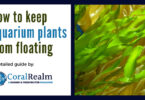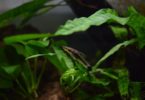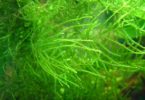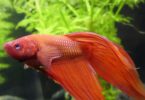Last Updated on February 12, 2023 by Jakob
This article aims to educate you on the benefits of having floating plants for aquarium, and why you should seriously consider whether you ought to get some for your aquarium tank. If you are looking for the best floating aquarium plants to stock in your tank – the consider our article specifically for that in the link.
We will also look at what factors you should consider when purchasing floating plants so you can ensure you get the correct fit for your fish tank.
Finally we will go over what we consider to be some choices of floating plants for aquarium you can use.
IN THIS ARTICLE
Types of Floating Plants For Aquarium – Complete Guide
Benefits Of Having Floating Plants For Aquarium
Low Maintenance and Easy Growing
First and foremost, the major benefit of having floating plants for aquariums is that they are incredibly easy to look after.
Rooted plants tend to require some special treatment, whether that be pruning or the conditions they need. When compared to rooted plants, floating plants require very little care. They are very hardy and can thrive in many different conditions. One thing to keep an eye on is the water temperature. Many of these plants are naturally found in tropical climates. If their temperature range is higher than that of your tank you will need an aquarium heater.
The only thing you’ll need to keep an eye on is that they don’t grow into a thick mat and block too much light to the base of the tank. Simply remove some when you think it’s getting too much, but be careful you have no fish or snails in there too!
Supplements Diet of fish inhabitants
Herbivorous and omnivorous fish will nibble and eat floating aquarium plants. This will supplement their diet and give them a natural source of additional food.
This will mean you don’t need to feed them as much with each feeding, or at least you’ll have to take it into account.
Unlike rooted aquarium plants which can react quite badly to being constantly nibbled and eaten, floating plants are so quick growing and small that it doesn’t pose an issue to them.
In fact you’ll be thankful that your fish do eat them as it means the growth of the floating plants will be kept under more control!
Provides a Source of Cover and Shade
Having floating plants in your aquarium will block some of the light to the bottom of the tank. While you do want light getting down there, many rooted freshwater plants and fish need lower light levels to thrive.
Aquarium LED lights can be very harsh, and while more premium options sometimes offer dimmer settings or emit light specifically in the spectrums to promote growth, the majority of lights just light the tank to look pleasing.
Having a source of cover and shade on the surface means you may see the more particular of your fish being more active and hiding away from the bright light less. You may also see the plants that like shaded areas thriving.
Appearance of floating plants for aquarium
Whilst the three benefits we’ve spoken about so far are about fairly practical, this is solely aesthetic. Floating plants will look good in your aquarium!
In most natural environments, and especially lakes, rivers, and pools, you will find floating plants. So having them in your aquarium makes it look more natural and organic. It will look a lot more like a mini bit of nature in your home.
Not only will the floating plants themselves look good, but your fish will be interested in them and will spend more time swimming at the top of the tank under their cover, meaning you’ll get a better look at your fish too!
Natural Filter
This effect isn’t solely found in floating plants for aquarium, but in all aquatic plants. Floating plants draw nutrients directly from the water column however, so have more of a filtering effect than rooted plants.
Plants require nutrients to grow and survive, and so will take these nutrients from the water column or substrate. Some of these nutrients are waste products created by fish and other living organisms in your tank. These nutrients can sometimes build dangerous levels, causing algal blooms or direct harm to your fish.
This natural filtering of the water will ensure that the water in your tank remains clear and free of cloudiness. It will also mean your fish have a much healthier and more natural environment to swim and be happy in.
Floating plants for aquarium that you can use
1) Java Moss
Java Moss is extremely popular among aquarists, providing a much more natural look to an aquarium. It is used extensively in aquascaping, the aquarium form of gardening, arranging stones, plants, and driftwood to create a beautiful setup.
Not only is it useful in aquascaping, it can also be used as a floating plant, where it will grow gently outwards from it’s attachment point. It does need something to anchor to, but a piece of cork works wonders. They attach themselves using rhizoids, little hair like roots, though you may have to attach the moss with wire or something similar until it attaches itself.
It is also extremely useful and popular amongst fish breeders, as it is a delicate moss with short stems and small leaves which provide a perfect place for fish to lay eggs, and for fish fry to hide and feel sheltered.
The ideal conditions to grow Java Moss are soft acidic water from between 70 to 75°F, though it is a very hardy plant and can tolerate conditions from 59 to 86°F, and a pH range of 5 to 8.
You can either let Java Moss grow as it wants, or you can maintain it to a specific shape by trimming it. You don’t need to be too careful with cutting as it is a very hard plant to kill!
If you want more in-depth information of Java Moss please read our complete Java Moss care guide.
2) Duckweed (Lemna Minor)
No doubt you will recognize duckweed from ponds, rivers and lakes. It is easily recognizable by its small leaves which is where it also gets the name water lentils.
Duckweed looks great in any freshwater aquarium, but be warned because they are very fast growing and due to its small size can be caught in the filtration system. Make sure you keep an eye on growth and remove any excess you don’t want, otherwise it will cover the whole surface!
Duckweed is a great looking floating plant for an aquarium. As good as it looks from above, if you get under and look at it from below it looks quite mesmerizing. The light coming through the leaves also looks great in the water column.
Small fish and fry especially love duckweed as they can find shelter and safety amongst it. However if you have labyrinth fish such as betta fish in your tank then it is probably not the good for you as it can easily grow to blanket the entire surface.
It is also very difficult to truly remove it from your tank, as even the smallest piece you leave and grow again. This is why it’s so successful in the wild! So make sure this plant is for you before you put it in your tank.
3) Mosquito Fern (Azolla filiculoides)
Native to California, the mosquito fern gets its name from the dense mat it creates on the surface of the water, so much so that it repels mosquitoes when they try to lay their eggs!
It is a quick grower, able to proliferate through fragments as well as spores. It can tolerate a wide range of conditions so will thrive in your aquarium. Be careful though as it can grow very rapidly and prevent light from reaching through if the growth gets out of hand.
The leaves grow from a single root, and the small individual leaves are very beautiful, marking this plant as one from the fern family. They can be various shades of green and red.
4) Cabomba
A very good looking floating plant which is able to survive numerous conditions, but it does have stricter light requirements than other plants, and does do well with aquarium plant fertilizers.
They prefer a pH range of between 6.8 – 7.5, a temperature of between 72 – 82 degrees Fahrenheit, and medium to high lighting. They prefer high intensity light, which is why having them as a floating plant can help to keep them healthy.
There are green, red, and purple varieties of this plant, with green being the easiest to grow and manage. It is quite a delicate plant which doesn’t do particularly well with being nibbled at, so keep it away from known culprits like cichlids or goldfish!
5) Red Root Floater (Phyllanthus fluitans)
Native to South America this outstanding floating aquarium plant is well-known and desired for its red roots and underbelly, and in high intensity lighting the leaves can turn red as well!
It propagates quickly and is extremely easy to care for, liking a temperature range of between 70° – 82°F, a pH range of between 6.5 to 7.5, and can be in low to high lighting. Though if you want red leaves as well as a red underside then high lighting is the way to go.
The only requirement this floating plant has is a low water movement. It doesn’t like lots of surface agitation. This plant provides significant amounts of oxygenation and denitrification if you are worried about losing the benefits of any aquarium powerheads you may have to turn down.
Red root floater creates a carpeting effect on the surface and generates lots of shade and will draw shy fish out into more central parts of your tank.
6) Hornwort (Ceratophyllum demersum)
Also known as Coontail, Hornwort is an extremely hardy plant able to tolerate a range of water conditions. This hardiness has enabled it in the wild to spread across the globe to every continent except Antarctica, becoming a pest as an invasive species.
This trait works in your favor for your aquarium, as Hornwort is almost guaranteed to thrive in your tank. This makes it an ideal plant for beginner aquarists, or those without the time to manage more demanding plants.
Though it is more common to have hornwort planted, they work just as well free floating. Surface dwelling fish love free floating Hornwort, as they hide amongst the leaves and it provides them with shade. It is also very useful if you have fry in the tank, as they find protection amongst the leaves.
As it is found naturally in ponds, marshes, lakes, and rivers, it is suitable for any freshwater aquarium. Though be wary if you have a smaller aquarium as it’s quick growth rate may see it get out of control and dominate the space.
It can handle a high range of temperature, from 59 to 86°F. As such it is often used both in tropical and cold water tanks. It can handle a pH range of 6 to 7.5. You can read our complete Hornwort care guide for more information.
7) Floating Bladderwort
A unique and extremely interesting plant to keep in your aquarium, floating bladderwort is carnivorous! But don’t worry about it devouring your fish, it feeds on tiny microorganisms called zooplankton. They tend to feed on invertebrate larvae, water fleas, and aquatic worms.
This carnivorous behavior is an adaptation to evolving in nutrient deficient conditions. The plant gets organic nitrogen and phosphorus from this predation.
The plant floats and grows at the surface of the water, and produces little bladder-like structures, hence the name, where it will catch and digest its prey. It will flower with bright yellow blooms, and is a real talking point in any tank.
8) Brazilian Pennywort (Hydrocotyle leucocephala)
Having large leaves which grow with a little spacing between each other, brazilian pennywort is a beautiful floating aquarium plant. The leaves grow to be about the size of a quarter in most cases, and have stunning veins which run through them.The stem grows in segments which provides an added layer of interest and beauty.
It is a fast growing and very hardy plant able to tolerate a wide range of tank conditions. It prefers a pH range of 6 – 7 and can thrive in almost any water temperature, from between 41 – 86°F (5 – 30°C). It isn’t fussy about lighting or CO2 concentration unlike other plants.
9) Water Wisteria (Hygtophila difformis)
A very popular freshwater plant species, water wisteria (Hygtophila difformis), can be grown both as a floating plant and as a rooted plant. It all depends on how you want to use it and how you want your tank to end up looking.
When it is grown as a floating aquarium plant, water wisteria grows outwards and forms a blanket effect. This is great for fish that like lower light levels and love to play amongst the leaves. It creates a secure environment for younger and smaller fish to feel safe.
They need direct light, which is perfect if you use them as floating plants, as they will get plenty! They like a temperature range of 70 – 82°F, prefer a neutral pH level of 6.5-7.5, and a water hardness of 5-15 dGH.
They are very quick growing, and you will need to watch the growth regularly and clip it if it gets too much. Some light still needs to penetrate down to the bottom of the tank! If you don’t watch the growth you can find that the wisteria starts to affect plant growth at the base of the tank.
They have fascinating tall, lace like green leaves which look amazing in any aquarium, and so are perfect to have at the surface. Many fish and especially shrimp love the leaves as a safe space.
10) Water Spangles (Salvinia minima)
A brilliant floating aquarium plant due to its very pretty appearance and easy care requirements. It is native to Central and South America, and likes a temperature range of 65° – 89°F (16° – 32°C), a pH range of 6.5 – 8.0, and likes medium to high lighting.
It is quite a large leafed floating plant, with long hanging roots. This makes it perfect for drawing out shy fish which like seclusion, and for any fry and young fish you have.
Water spangles do prefer lower water movement, and in these conditions will grow very rapidly to cover the whole tank. You can counter this by regularly trimming them back, or by creating a ring of air tubing where you would like light to get through. This can create a very mesmerizing effect.
11) Amazon Frogbit (Limnobium laevigatum)
Another plant out of Central and South America, Amazon Frogbit is a very popular aquarium floating plant as it looks and acts as a miniature lilypad. Juvenile plants have their leaves laying flat on the water and mature plants will have some leaves slightly raised as well. They will also flower, producing beautiful small white flowers, which makes it one of the most attractive floating plants available.
They like a temperature range of 64 – 84°F (18 – 29°C), a pH range of 6.0 – 7.5 and medium lighting. As like most floating aquarium plants they can grow to cover the entire surface so regular trimming and thinning should be done to ensure that light still penetrates to the bottom and rooted plants don’t suffer.
It is a very easy plant to grow and care for, which makes it perfect for beginners, but there is one important thing you need to look out for. If the tops of the leaves get wet it will cause the leaf to rot! So be careful that no water is on the tops of the leaves after water changes and tank cleanings and the like.
12) Rotala Indica
An amazing plant to be floated, it can also be rooted in the substrate happily as well. It has green leaves which are pinkish on the bottom, which creates a fascinating contrast at the top of your tank, especially when you have the natural water and fish movement added in!
It likes to have a water temperature of 71 – 82°F (22-28°C), and a pH level of 6.0 to 7.5. If you have high intensity lighting then the tips of the stems will turn reddish, while a lower light level will mean bigger broader leaves and a more open plant.
You can let this plant grow thick and bushy or you can keep it trimmed down to create a sparser look, it is completely up to you!
Takeaways: Floating plants for aquarium
Finding floating plants for aquarium will give your tank a much more natural look, as well as providing much needed shelter and safety for your fish. They also provide natural filtration and help to oxygenate the water.
Many of these plants are very hardy and fast growing, which means you will have to spend minimal effort to grow them.
They are also able to handle having a couple of bites being taken from them, meaning they can help to naturally supplement your fish’s diet.



